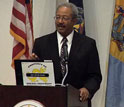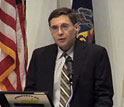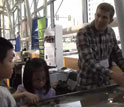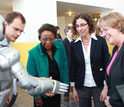News Release 11-204
National Convocation Highlights Best Practices for Improving STEM Education
Leaders and educators share effective approaches in science, technology, engineering and mathematics (STEM) education, with 31 interactive exhibits showing the latest innovations supporting science teaching and learning
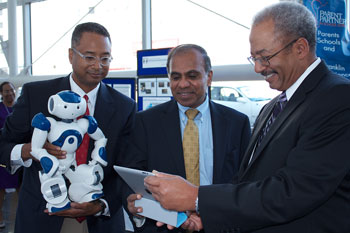
Shown (left to right) are Andrew Williams of Spelman College with Subra Suresh and Rep. Fattah.
September 26, 2011
View videos of Congressman Chaka Fattah (D-PA), Carl Wieman of the White House Office of Science and Technology Policy; and Douglas Jerolmack, Associate Professor at the University of Pennsylvania.
This material is available primarily for archival purposes. Telephone numbers or other contact information may be out of date; please see current contact information at media contacts.
According to a recently released report issued by the National Research Council (NRC), the primary drivers of future economic growth and job creation will be innovations largely derived from advances in science and engineering. An increasing number of jobs at all levels--not just for professional scientists--require knowledge of science, technology, engineering and mathematics (STEM). The stakes are high for U.S. students and those who teach them. The report, "Successful K-12 STEM Education," provides best practices for STEM teaching and learning in a wide range of environments, and a series of recommendations geared toward school districts and policy makers.
To focus national attention on the NRC report and its recommendations, on September 19 at Drexel University in Philadelphia, elected officials and government leaders came together with educators to share lessons learned based on the NRC study, which was funded by the National Science Foundation (NSF). About 300 educators, policy makers and business professionals attended a full day of activities, intended to launch a national effort to put the ideas from the report into action.
The mayor of Philadelphia, the president of Drexel University and U.S. Congressman Chaka Fattah of Pennsylvania's Second District helped kick off the event, followed by Subra Suresh, director of NSF; Carl Wieman, Associate Director for Science, White House Office of Science and Technology Policy; Cora Marrett, deputy director of NSF; and Adam Gamoran, who chaired the NRC study. Joan Ferrini-Mundy, NSF assistant director for Education and Human Resources, wrapped the discussion with a call to action at the end of the day.
Panels throughout the day promoted a rich discussion of the role of common standards, STEM learning outside of school, equal access, and other topics, while 31 exhibits showed the latest innovations supporting science teaching and learning. Visitors could interact with a humanoid robot; race underwater remotely-operated vehicles; see the impact of dams on river flows in a table-top model; and examine the portable weather stations used to take wind and temperature measurements in the middle of a tornado, among other activities.
"The 21st century is the century of science and technology--not just for people who are in the STEM enterprise, but for the average citizens of the world," said Suresh. "They have to be science-savvy, they have to be engineering savvy, they have to be technology savvy, just to survive in the global competitive landscape."
The recommendations of the NRC report are key to building on a way forward for schools, districts and policy makers in improving STEM teaching and learning in classrooms across the country. The report was requested by Congressman Frank Wolf (R-Va.), chairman of the House Appropriations Subcommittee on Commerce Justice Science and related agencies. Congressman Wolf sent a letter congratulating NSF and the NRC on the event; the letter was read during the opening session.
This event was the first in a series of events on this topic. Regional meetings are being planned to further disseminate the report and its recommendations to practitioners, state and local STEM education leaders, and others. The report's findings will be shared with these groups in the months ahead and will guide future research in the field.
-NSF-
-
View Video
Congressman Chaka Fattah (D-PA) acknowledged NSF with educating future scientists and engineers.
Credit and Larger Version -
View Video
Carl Wieman of the White House Office of Science and Technology Policy talks about STEM education.
Credit and Larger Version -
View Video
Douglas Jerolmack of the University of Pennsylvania uses a stream table to teach kids.
Credit and Larger Version -
(Left to right) Cora Marrett, Dahlia Sokolov and Joan Ferrini-Mundy interact with Jaemi HUBO.
Credit and Larger Version
Media Contacts
Maria C. Zacharias, NSF, (703) 292-8454, email: mzachari@nsf.gov
Related Websites
STEM Smart: Lessons Learned From Successful Schools: http://successfulstemeducation.org/content/agenda
The U.S. National Science Foundation propels the nation forward by advancing fundamental research in all fields of science and engineering. NSF supports research and people by providing facilities, instruments and funding to support their ingenuity and sustain the U.S. as a global leader in research and innovation. With a fiscal year 2023 budget of $9.5 billion, NSF funds reach all 50 states through grants to nearly 2,000 colleges, universities and institutions. Each year, NSF receives more than 40,000 competitive proposals and makes about 11,000 new awards. Those awards include support for cooperative research with industry, Arctic and Antarctic research and operations, and U.S. participation in international scientific efforts.
Connect with us online
NSF website: nsf.gov
NSF News: nsf.gov/news
For News Media: nsf.gov/news/newsroom
Statistics: nsf.gov/statistics/
Awards database: nsf.gov/awardsearch/
Follow us on social
Twitter: twitter.com/NSF
Facebook: facebook.com/US.NSF
Instagram: instagram.com/nsfgov



